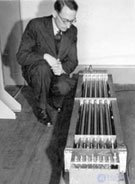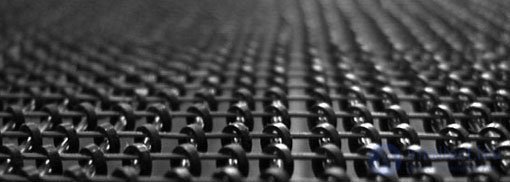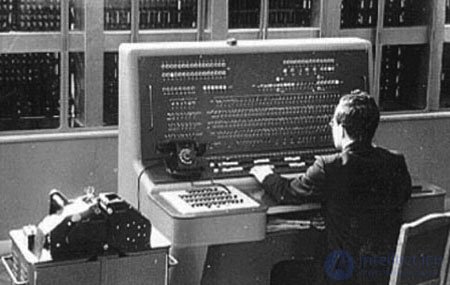Lecture
Without taking into account the elemental base of computers, one could say that the first computer was developed by Alan Turing “Kolos” developed back in 1943. This machine was designed to decrypt German secret messages from the Second World War. It was one of the first attempts to create a universal programmable machine. However, today's definition of the computer did not match.
Component base of computers of the first generation are vacuum tubes. They were intended to solve scientific and technical problems. These machines possessed the military departments and state institutions. Their cost was so high that even large corporations could not acquire them. These machines were of enormous size and weighed about 5–30 tons, occupying an area of several hundred square meters. So they often needed separate rooms, and sometimes entire buildings. Consumer power of such machines was measured in hundreds of kilowatts of energy. For example, the machine ENIAC consumed 150 kW. Some of them operated with decimal numbers, such as Mark-1 , rather than binary ones like existing machines.
The computing power was only a few thousand operations per second. For example, such operations as addition, subtraction took several seconds. The division and multiplication took up to several tens of seconds. And it took more than a minute to calculate the logarithm or trigonometric function.
Element base of computers of this generation were: electromechanical relays, which quickly broke down and created a lot of noise like in the production workshop, electronic vacuum tubes whose service life did not exceed several months. There were tens of thousands of them in the car. So every day, something broke.

 |
| Memory on ferrite cores was used in the first generation of machines. |
All performance was determined by the slowest element - the internal memory which reduced overall efficiency. During the first generation, they tried to remove this disadvantage due to the asynchronous operation of the components. Introduce the concept of a buffer when the transmitted data was copied to the buffer, freeing the device for the following operations. Even then, the own memory was used to operate the I / O device.
A big disadvantage of the first generation is that initially these machines were designed to perform arithmetic tasks. And the decision on them of any analytical tasks was very time consuming.
Computers of the first generation in Russia appeared late. These include MESM - Small Electronic Counting Machine developed at the Institute of Electrical Engineering of the Ukrainian Academy of Sciences under the guidance of S.А. Lebedeva 1950. The first generation also includes such machines as BESM, Ural, M-2, Strela.
 |
| Domestic computer of the first generation BESM-2. It contained about 4,000 electronic tubes. It was assembled on three racks; one of them was a magnetic random-access memory rack and a control panel. |
Comments
To leave a comment
History of computer technology and IT technology
Terms: History of computer technology and IT technology